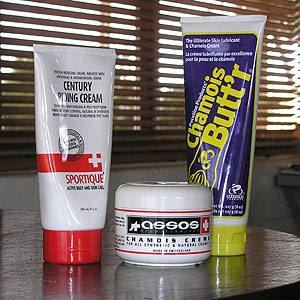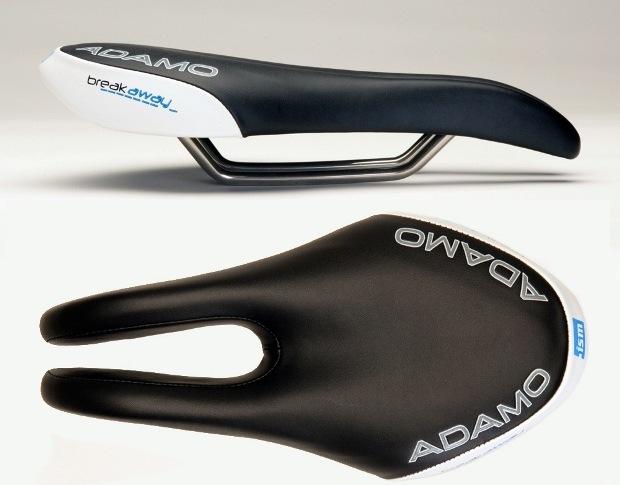2Toms Review
Are you a triathlete? Do your running shorts smell bad? Do you buy Vaseline in 5-gallon buckets at Costco because you chafe so much? Does your wife force you to keep your cycling shoes in the garage because they stink like a high school gym locker?
If you answered ‘yes’ to any of these questions, 2Toms has an answer for you. What the heck is 2Toms? Started in New Hampshire by Tom Lewis and Tom Judd, this company specializes in endurance sports solutions. Specifically, they seek to keep us from stinking to high heaven while chafing ourselves into oblivion.
The first Tom (Lewis) of 2Toms has a PhD from MIT in surface chemistry. He’s also an avid endurance and ‘extreme’ athlete, and knows all about the pain and frustration of blisters. He began developing anti-chafe formulas out of his own self-interest, but lacked a business background to take his product to market. Through a mutual friend, the first Tom was introduced to the second Tom (Judd), who is also an avid endurance athlete. As fate would have it, he is also an entrepreneur and business specialist. The two officially launched their company, dubbed 2Toms, in 2002.
This article is an overview of their current product line, along with my impressions from testing it.
BlisterShield
MSRP $12.99 (8 oz powder or 10 x single packets)
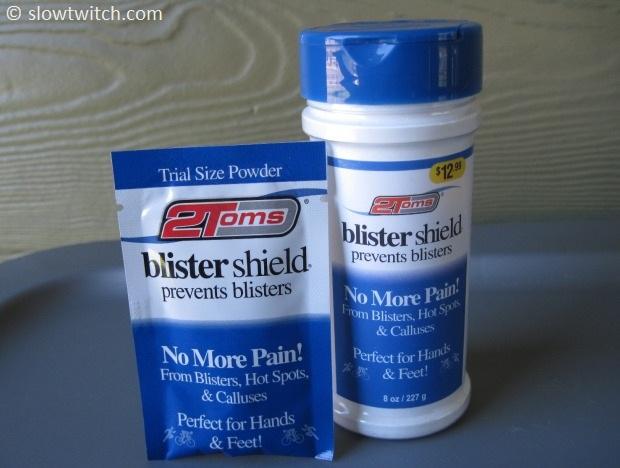
BlisterShield is 2Toms’ core product for keeping your feet dry and free of blisters. While it might look similar to, say, talcum powder – it is very different. In fact, the main ingredients are actually PTFE (Teflon) and PE wax. BlisterShield is intended to create a near frictionless surface on your feet, to reduce heat buildup and the blisters that follow. In addition, it is highly water resistant to keep your feet dry for long periods of time.
As you can see, the container lid allows you to either sprinkle the product wherever you want, or use a spoon for a measured amount. 2Toms recommends about 1 teaspoon per sock for most people. Just measure it out, pour it in, and shake it around in the sock.
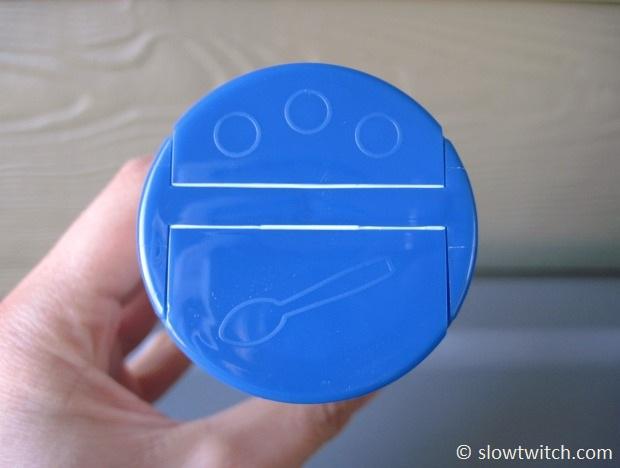
While baby powder is rather fine-grain, Blistershield tends to create little ‘snowballs’:
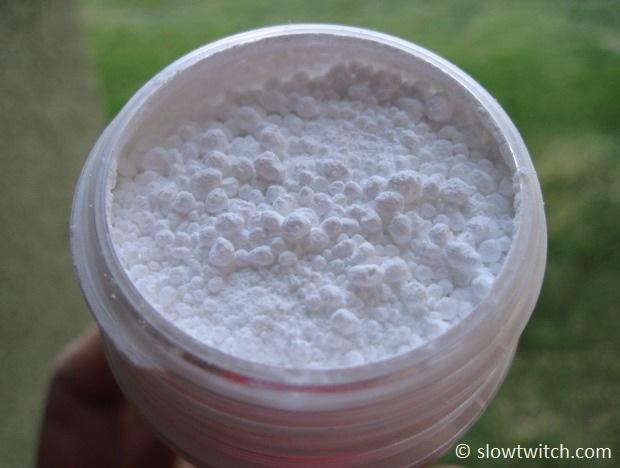
Once you spread it around on your foot (or hand, or whatever), the product really becomes a slick film.
While it may look similar to climber’s chalk, it is definitely not the same thing. Chalk is typically made from magnesium carbonate, limestone, or dolomite. Their intent is to keep the climber’s hands dry, but not reduce friction. BlisterShield, on the other hand, is intended to keep you dry, but really slippery.
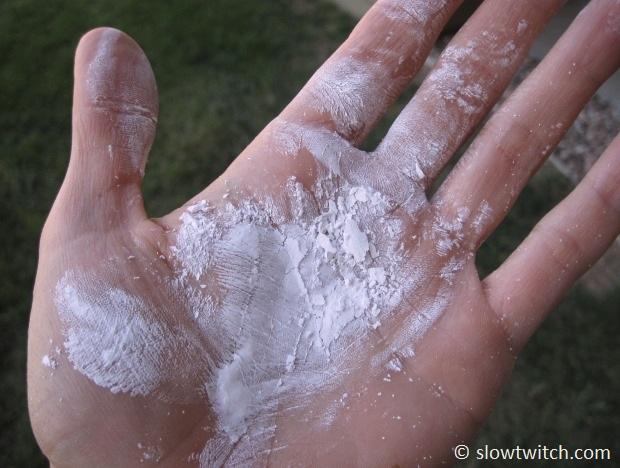
Does this stuff really work? I found that yes, it does really work. Put it in your socks, shake, and go. I think it’s a fantastic product for Ironman racing. Just pre-apply it to the inside of your socks, put a rubber band around the top of the sock, and stash them in your bike-to-run bag. If you’re extra-blister-prone, you could even put a pair of fresh socks with more BlisterShield in your ‘special needs’ bag.
The only rub with BlisterShield (pun intended) is the question of whether or not you like your feet super slippery. Also – how tight do you like your shoes and laces? If you prefer looser shoes and/or laces, there is potential that your foot will slide around inside the shoe with BlisterShield. Mind you, your chance of getting blisters goes down by using the product, but some may find the ‘slidy’ feeling to be strange. I personally prefer shoes that are a little more on the roomy side, so I ended up not using BlisterShield as an everyday training tool. I save it for racing, when my shoes are laced tighter, and I seem to be much more prone to blisters in general.
SportShield
MSRP $12.99 (1.5 oz roller or 10 x single wipes)
Think of SportShield like the liquid version of Blistershield. It can be applied with either an easy-to-use roller stick, or via pre-soaked wipes.
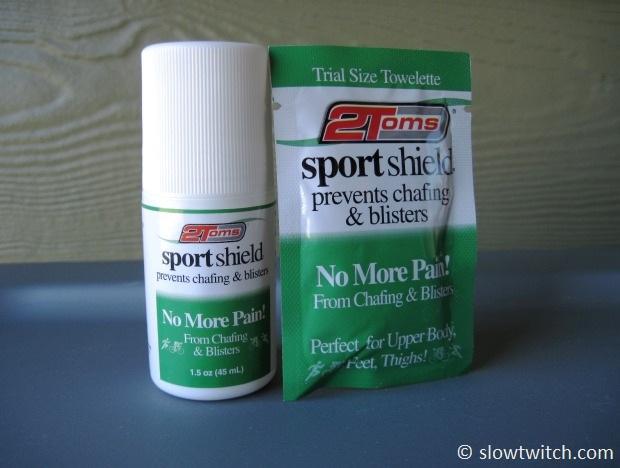
And boy, is this stuff slick. Whereas some of the competing products can tend to feel thick or sticky, SportShield feels more like a very slick film that you apply right to your skin. It’s an odd sensation the first time you use it. With something like a petroleum jelly, I see people just globbing a bunch on to create a thick barrier. Once it has all been mechanically pushed out of the way, you’re back to skin-on-skin, and the ever-enjoyable feeling of chafing.
In comparison, SportShield feels like it binds to your skin more. It isn’t going anywhere. I think it might not work as well at ‘saving’ someone who has a very ill-fitting wetsuit; they’re going to be best served by a super thick goop. For just about every other situation, however, I found that SportShield does the job very well. Use it on the back of your neck for wetsuit swimming. Use it between your thighs for running. Guys – and I apologize for the graphic nature of this – put it on your nipples because nobody wants to see them bleeding by mile 20 of the marathon.
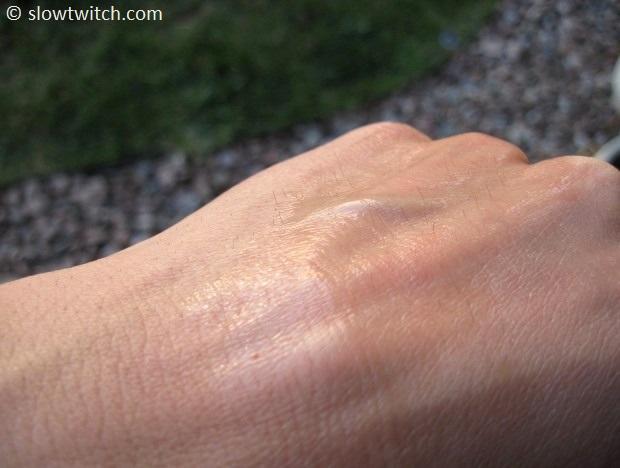
You may be wondering – can I use SportShield for my feet? Does it work like BlisterShield? Yes and no. If you really don’t like powder products and prefer a roll-on, you can use SportShield for your feet. It’s really slick, yes. But – it does not have the anti-moisture properties that you get from the PTFE-containing powder.
The mini towelettes are great for a transition bag or ‘special needs’ bag. I should issue a caution, however: Once you get this stuff on your hands, wash them immediately. The product does wash away with a good soap-and-water hand wash. If left on your hands, it will be with you for quite a while. This being the case, I prefer using the roll-on stick. If you grab it only by the handle portion, it helps avoid getting the actual product on my hands.
ButtShield
MSRP $12.99 (1.5 oz roller)
ButtShield? Seriously – ButtShield?! You read correctly. It’s like a knight-in-shining-armor (with a shield) for your derriere. Kind of. Well… not really.
What the heck is ButtShield? Take 2Toms’ SportShield product and supercharge it with shea butter, calendula extract, green tea extract, and horsetail plant extract. They say that the result is uniquely suited for applying to your rump.
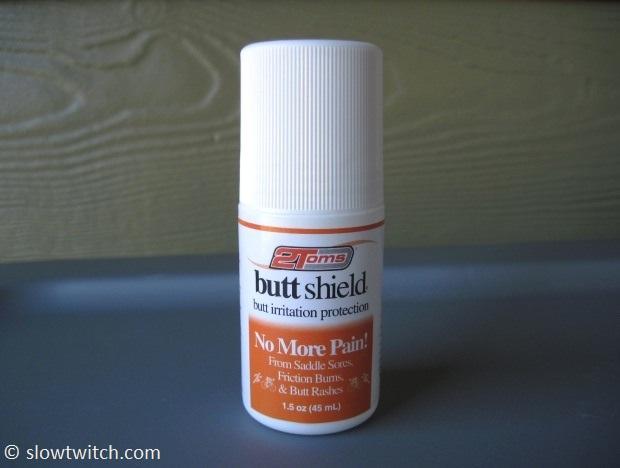
Out of the entire 2Toms product line, ButtShield is the one that piqued my interest the most. While speaking with their super-enthusiastic representative, Dave Sullivan, he said that this product can actually be used as a substitute for chamois cream. The traditional (okay… the downright snooty) cyclist in me scoffed. Nothing could be better than my beloved Assos or DZ Nuts chamois cream. How could it? The Assos cost me $23 for a small tub, and my buyer’s remorse is still trying to convince me it was worth every penny. Everyone who’s anyone in the cycling world knows that you must use a proper chamois cream. If it doesn’t contain menthol, sting your skin, and stink up the coffee shop, it just isn’t true chamois cream.
Sorry to burst your bubble, but I’m going to burst your bubble. I think ButtShield IS better than regular chamois cream. There, I said it. In fact, I could see this being the new triathlete’s chamois cream. Let’s keep it as our little secret, shall we? The roadies can keep thinking that their stuff is better.
How does it work? You use it just like SportShield; roll it on. This is where my only criticism of the product comes out. To be frank, you’re fighting gravity. Take a look at the roller:
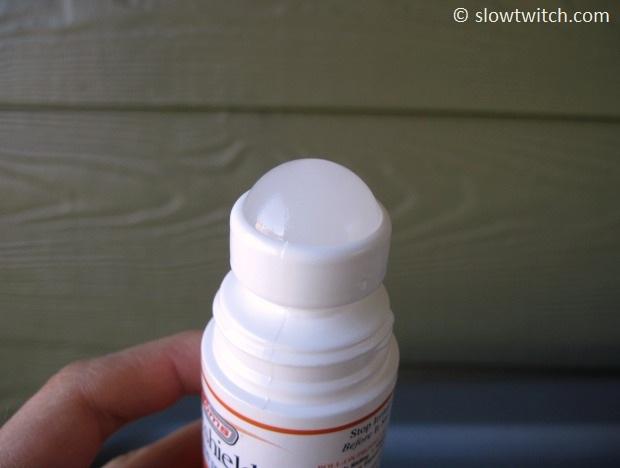
It works like a ballpoint pen. When you hold it upside down and roll it around, gravity does all the work and dispenses the product. But… when you want to apply it to your butt, the roller must be placed right side up. No gravity assistance = no ButtShield coming out.
The easy fix is hold the roller upside down and dispense some of the product somewhere else before your tender areas. I don’t care what you do – lube up a foot, spread a little around on your chamois – you just want to get the flow started.
I’ll be honest. I was super skeptical of the product before I used it. When I did use it, though, I was quickly convinced of its effectiveness. The sensation is hard to describe. Compared to traditional chamois cream, it’s a different experience entirely. It’s a LOT more slippery. A cream tends to be sticky – and stick your shorts to your bum. ButtShield truly keeps your butt and shorts independent of each other. It’s slick, but not uncomfortable or strange. The best part is it lasts a very long time. Other chamois creams I’ve used can dry up towards the end of a long ride and stop doing their job. While I haven’t done anything over about 4 hours (yet) with ButtShield, my initial tests leave me with high hopes.
Stink Free Spray
MSRP $9.99 (8 oz pump bottle)
Your shoes smell. I don’t even pose that as any sort of a question, because there IS no question. If you’re a triathlete, your shoes stink. That goes double if you race anything half-iron distance and longer, because that means you probably pee in your shoes. Sweat, sports drink, urine, and gamey lake water make for a concoction that a skunk would be proud of.
While we tend to retire running shoes several times a year, we usually want our cycling shoes to last longer. Rather than deal with the smell, 2Toms suggests you try their Stink Free Spray. They say it contains no perfumes, and leaves your shoes (or gym bag, or whatever) with ‘no smell’. They should smell like nothing.
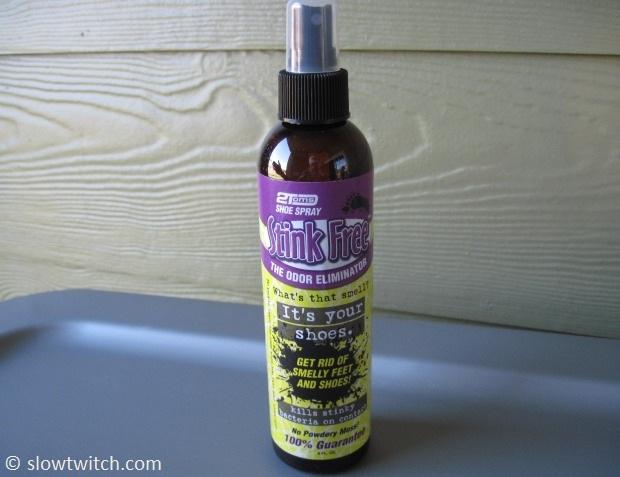
I decided to take the Pepsi Challenge and try this stuff on an old pair of cycling shoes. I’d retired them from use about a year ago, but kept them around as a backup. They’d been washed multiple times with soap and water, sprayed with Febreze®, and aired out for days. They still smelled awful, so I couldn’t stand to use them anymore.
I took them out from the garage, to find that they just smelled like a combination of Febreze® and the remaining old funk. Not good. I sprayed the shoes with Stink Free Spray, set them outside and waited. The next day, I checked back, to find that they did smell better. Not 100% better, but better. 2Toms suggests spraying your shoes two or three times if they’ve never been sprayed before. I gave them another spray, and waited another 24 hours. They were a step better yet again. While I’m not sure you can restore a pair of shoes to a completely-new state, you can certainly get them back to ‘acceptable’, and perhaps squeeze another season out of shoes that would otherwise be headed to the garbage.
Stink Free Sports Detergent
MSRP $14.99 (30 oz bottle)
Stink Free Sports Detergent is like Stink Free Spray for your clothes. 2Toms says that the cause of stinky sportswear is a combination of bacteria and moisture-wicking clothing. In their own words:
“Many of today’s high-tech fabrics are designed to wick sweat away from your skin, absorbing moisture and keeping you dry. The problem is these sweat-wicking fabrics lock in the stink, too. Regular laundry detergent is formulated for lightly soiled cotton-based fabrics, and cannot effectively get the odor out of your stinky socks, smelly shoes, sweat-stained shirt, etc. The only thing that can get your smelly clothes fresh is a sports detergent specifically formulated to eliminate the sweat left in the clothing that causes odors.”
They say that their detergent works on all sports-related apparel. It’s perfume and residue-free, and works in both standard and high-efficiency washers.
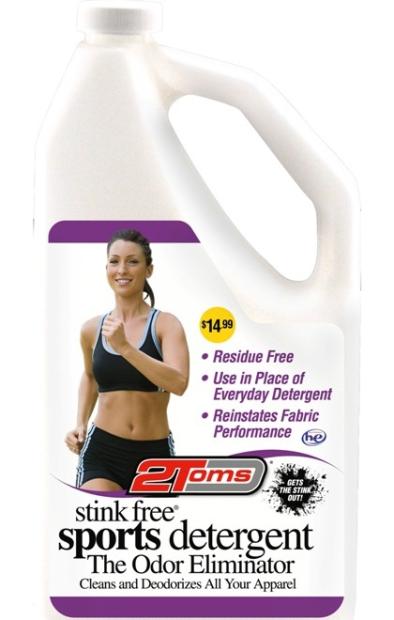
This is one product of theirs that I haven’t yet devised a good test for. To be honest, I’ve never had trouble with normal detergent getting rid of smells from my cycling and running apparel. I also don’t know how much I want to endanger my happy home life by wearing the same shorts for five days just to compare detergents. If you or your spouse is a particularly stench-laden person, and traditional detergent doesn’t cut the mustard, this could be the cure you’re looking for. The other good use for it is race travel – you can buy little 2-load sample packets, which pack perfectly in a suitcase (so you can wash out that nasty kit post-race). Nobody likes arriving home and opening up a funky suitcase full of dirty race clothes.
We hope you enjoyed this look at the 2Toms product line. While they aren’t yet as well-known as some other brands, I found their product to work impressively well. If nothing else, I encourage you to try ButtShield. Heck, I don’t care – give it as a stocking stuffer for your chafe-prone significant other. Just be sure to buy a separate one for yourself, for obvious reasons (this is one item you do not want to share). I’m personally curious to see if it really catches on as the discerning triathlete’s chamois lubricant. If you've tried it before, we would love to hear your comments – good or bad.




